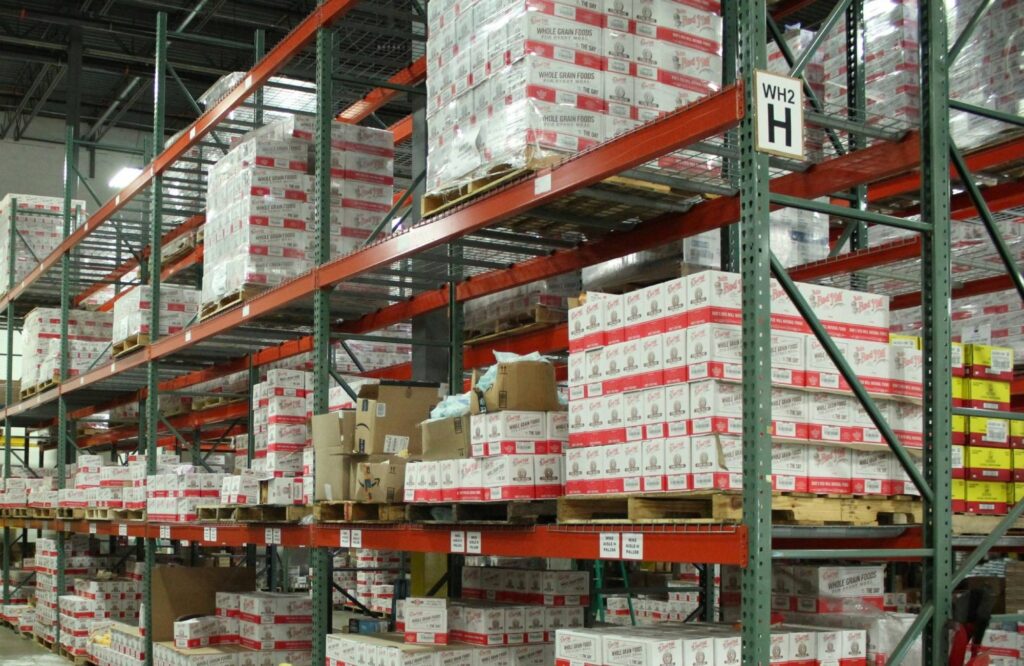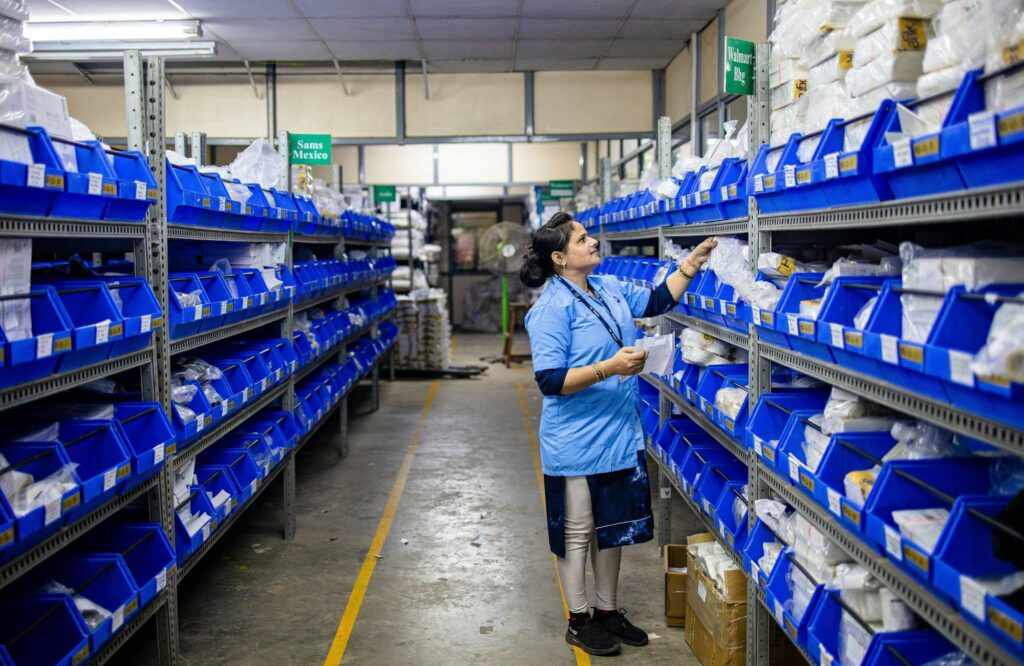Pharmaceutical warehousing is one of the most demanding sectors when it comes to inventory control, regulatory compliance, and environmental safety. Unlike general warehousing, pharmaceutical products often require strict temperature regulation, clean environments, and sophisticated tracking systems to ensure product integrity. That said, choosing the right warehouse storage solutions is crucial.
This is where optimized commercial warehouse storage systems come into play. By identifying and investing in eight essential features, pharmaceutical companies can ensure they’re partnering with storage warehouse services that are compliant, efficient, and future-ready.
Table of Contents
Key Takeaways✔ Pharmaceutical storage requires precise temperature and humidity control, including multi-zone environments, real-time monitoring, and reliable backup systems to ensure stability and compliance. ✔ Maintaining cleanroom-compatible, contamination-free storage relies on HEPA filtration, directional airflow, GMP layouts, and strict sanitation to protect product integrity. ✔ Full regulatory compliance and traceability are achieved through serialization, barcode/RFID tracking, and audit-ready documentation aligned with global standards. ✔ Robust security and access control systems safeguard sensitive inventory using surveillance, restricted zones, cybersecurity, and compliance with DSCSA protocols. ✔ Efficient handling of varied products depends on customizable racking and shelving systems that adapt to size, volume, and movement needs without sacrificing space or safety. ✔ Advanced inventory management systems ensure real-time visibility, automate stock control, and integrate with ERP platforms to support accurate, compliant operations. ✔ Strong disaster preparedness and backup systems are essential, including power redundancy, fire protection, flood control, and trained emergency response teams. ✔ Future-ready scalable infrastructure enables warehouse growth with modular layouts, automation readiness, IoT monitoring, and flexibility for regulatory changes. |

1. Temperature and Humidity Control
Pharmaceutical products are highly sensitive to environmental conditions. Proper temperature and humidity control are mandatory to preserve efficacy, ensure patient safety, and maintain compliance with regulatory standards. According to 21 CFR Part 211.142(b), drugs must be stored under conditions that prevent their identity, strength, quality, and purity from being affected.
Secure warehousing providers that implement these controls help pharmaceutical companies protect inventory, meet compliance standards, and reduce the risk of spoilage throughout the supply chain.
Key Aspects of Temperature and Humidity Control
- Multiple Temperature Zones: Facilities must accommodate a range of storage requirements. These include cold chain storage between 2°C and 8°C for vaccines and biologics, frozen storage at -20°C or lower for certain plasma products, and controlled room temperature environments ranging from 15°C to 25°C for oral medications.
- Redundant Cooling Systems: Backup power sources and secondary cooling units must be in place to ensure refrigeration systems remain operational during outages or equipment failures.
- Calibrated Temperature Sensors: Strategically placed sensors provide real-time temperature data to warehouse personnel and quality control teams, enabling proactive management of sensitive products.
- Automated Alert Systems: Integrated monitoring platforms send instant notifications via email or SMS when temperature deviations occur, helping staff respond immediately to protect inventory.
- Validated Environmental Monitoring Systems (EMS): These systems continuously track temperature and humidity data over long periods, which is essential for audit readiness and historical verification.
- Humidity Management Tools: Warehouses should utilize tools such as desiccant chambers for enclosed spaces and industrial-grade dehumidifiers to maintain relative humidity levels between 30% and 50%, reducing the risk of microbial growth and packaging degradation.
- Documentation and Logging: All environmental data, including temperature and humidity logs, must be accurately recorded and securely stored to meet regulatory documentation standards and facilitate inspections.
2. Cleanroom-Compatible and Contamination-Free Storage
In pharmaceutical warehousing, preventing contamination is as important as ensuring proper storage conditions. Even trace levels of dust, bacteria, or chemical residue can compromise product integrity or trigger costly recalls. Commercial warehouse storage providers that implement these standards offer the pharmaceutical industry an environment where drugs and raw materials can be stored without risk to quality or compliance.
Essential Features of Contamination-Controlled Storage
- HEPA Filtration Systems: High-efficiency particulate air (HEPA) filters capture at least 99.97% of airborne particles, promoting sterile air circulation and reducing contamination risks in sensitive zones.
- Positive and Negative Air Pressure Zones: Cleanrooms use positive pressure to push contaminants away, while containment areas for hazardous substances use negative pressure to prevent their spread within the facility.
- Cleanroom-Compatible Materials: Shelving, flooring, and walls must be constructed from non-corrosive, easy-to-sanitize materials such as stainless steel or epoxy coatings to prevent bacterial buildup and support long-term durability.
- Sanitation and Hygiene Protocols: Facilities must follow rigorous cleaning routines using approved disinfectants. Hygiene stations with gowning rooms, personal protective equipment (PPE), and air showers reduce the risk of human-borne contamination. All cleaning procedures must be logged and verified regularly.
- Product Segregation and Zoning: Pharmaceuticals must be separated based on classification. For example, hormones, cytotoxic drugs, and general medications require physically distinct zones for receiving, storing, and dispatching, minimizing the chance of cross-contamination.
- Pest and Microbial Control: Preventive strategies such as regular UV and ATP microbial testing, pest-proof construction, and sealed dock doors help maintain hygienic conditions throughout the warehouse.
- GMP-Compliant Layouts: The design and flow of the warehouse must adhere to Good Manufacturing Practices (GMP), ensuring unidirectional movement of goods and personnel from clean to less clean areas to prevent backflow contamination.
3. Regulatory Compliance and Traceability
Ensuring regulatory compliance and traceability is a foundational element in pharmaceutical warehousing. These standards are not optional—they are enforced by global health agencies to protect patients and maintain supply chain integrity. These features ensure that pharmaceutical companies using advanced warehouse storage solutions remain compliant, traceable, and prepared for audits at all times.
Key Components of Regulatory Compliance and Traceability
- Global Regulatory Alignment: Pharmaceutical storage operations must adhere to guidelines from the FDA, EMA, Health Canada, and other international health agencies. Facilities that meet multi-region standards offer better flexibility and legal protection for global distribution.
- Comprehensive Product Identification: Each product stored must be clearly labeled with essential data such as lot numbers, expiration dates, SKU codes, and storage conditions. This ensures accurate tracking, simplifies recalls, and supports compliance documentation.
- Advanced Traceability Tools: Technologies like barcode systems and RFID tagging enhance the accuracy and speed of item tracking. These systems improve visibility throughout the warehouse and allow for seamless inventory verification.
- Serialized Inventory Management: Serialization adds a layer of protection by assigning a unique identifier to each unit. This enables pharmaceutical companies to trace products through every step of the supply chain and prevent counterfeit drugs from entering circulation.
- Audit-Ready Documentation: Records related to storage conditions, handling, movement, and inventory levels must be readily accessible. Digital logs created through Warehouse Management Systems (WMS) provide timestamped, tamper-proof documentation required during inspections or audits.
- Integrated Compliance Dashboards: Real-time dashboards allow quality assurance teams to monitor conditions such as temperature compliance, lot expiry timelines, and inventory accuracy. This proactive oversight reduces the likelihood of regulatory violations.
- GDP- and ISO-Certified Services: Working with storage warehouse services that hold Good Distribution Practices (GDP) or ISO certifications demonstrates a commitment to standardized processes, quality management, and continuous improvement.
4. Security and Access Control Systems
Pharmaceutical products are valuable and highly regulated, making them attractive targets for theft, tampering, or cyber intrusion. A robust security framework is essential to protect both inventory and sensitive operational data. By implementing these measures, pharmaceutical companies can trust their commercial warehouse storage provider to maintain a secure warehousing environment that protects inventory, data, and compliance integrity.
Core Elements of Warehouse Security
- Physical Security Infrastructure: Facilities must be equipped with high-resolution surveillance cameras that operate 24/7, along with intrusion detection alarms on all entry points. These systems deter theft, support incident investigations, and ensure compliance with physical security standards.
- Access Control Measures: Restricted access to high-risk areas such as controlled substance zones is crucial. Biometric entry systems and digital key cards help track who enters the premises, when, and for what purpose. Logging all activity ensures accountability and aids in identifying unauthorized actions.
- Data and Cybersecurity: Protecting digital inventory systems is just as important as securing the physical warehouse. Firewalls, encryption, secure login protocols, and multi-factor authentication safeguard sensitive product data and customer information from cyber threats.
- Regulatory-Driven Security Protocols: Compliance with regulations like the Drug Supply Chain Security Act (DSCSA) requires warehouses to establish comprehensive product tracking and reporting systems. Adhering to these standards reduces the risk of diversion and ensures the legitimacy of all inventory.
- Security Staff and Emergency Protocols: Facilities must employ trained security personnel capable of responding to breaches and executing emergency procedures. Regular drills and clear protocols help minimize damage during security incidents or natural disasters.
- Inventory Reconciliation Audits: Conducting frequent audits ensures that stored inventory matches recorded data. Any discrepancies may signal internal errors or potential theft and must be investigated immediately.

5. Customizable Racking and Shelving Systems
Pharmaceutical warehouses handle a wide variety of products, ranging from fragile glass vials to bulky drums of raw materials. This diversity demands storage systems that are not only strong and stable but also versatile and space-efficient. Commercial warehouse storage providers that offer flexible and intelligent racking systems enable better space utilization, fewer picking errors, and faster response times.
Essential Features of Customizable Storage Systems
- Adjustable Shelving Designs: Modular racks and shelves can be resized or repositioned based on product dimensions. This adaptability allows the same system to store syringes, cartons, bulk powder containers, and more without requiring a complete redesign.
- Mobile and High-Density Storage Options: Mobile shelving units maximize space in compact facilities, while high-density racking systems increase capacity without expanding the warehouse footprint. Both support higher inventory volumes and better organization.
- Pallet and Case Flow Racks: These systems use gravity or rollers to ensure automatic stock rotation, which is ideal for time-sensitive items. It minimizes manual handling while supporting FIFO protocols for drugs with short shelf lives.
- Mezzanine Floors and Vertical Expansion: Utilizing vertical space through mezzanines or tiered shelving helps maximize capacity, especially for facilities operating in limited square footage. This also allows physical separation of products with different handling requirements.
- Integrated Picking Aids: Shelving systems can be equipped with pick-to-light or voice-pick technology, improving accuracy and efficiency in order fulfillment. These systems are especially useful in high-volume pharmaceutical distribution.
- Ergonomic and Safety-Conscious Designs: Adjustable racks minimize strain during picking or restocking and reduce the risk of workplace injuries. This is particularly important when handling hazardous or heavy pharmaceutical materials.
6. Efficient Inventory Management Systems
Pharmaceutical warehousing demands flawless inventory accuracy due to the nature of the products being stored. Managing thousands of SKUs requires a highly capable and integrated system. Storage warehouse services that implement these intelligent systems offer pharmaceutical clients unmatched control over their inventory. Modern warehouse storage solutions powered by real-time data help ensure that products are always available, traceable, and handled with precision.
Key Features of Advanced Inventory Management
- Real-Time Inventory Visibility: WMS platforms track every unit from arrival to dispatch. Real-time updates help prevent stockouts, identify overstocks, and reduce lost or misplaced items, which can be costly and disruptive.
- Expiration and Recall Alerts: The system can automatically flag products nearing expiration or involved in recall notices. This function supports regulatory compliance and patient safety by ensuring timely removal or distribution.
- Automatic Replenishment Triggers: Minimum and maximum stock levels can be configured to generate purchase or transfer orders when inventory drops below the threshold. This reduces manual oversight and ensures critical drugs are always in stock.
- Integration with ERP and TMS Systems: Seamless connection with Enterprise Resource Planning (ERP) and Transportation Management Systems (TMS) allows synchronized operations between procurement, warehousing, and logistics. This leads to faster decision-making and reduced lead times.
- Cloud-Based Accessibility: Cloud-hosted platforms offer remote access to dashboards, reports, and alerts, enabling better oversight for multi-site or global operations. Decision-makers can monitor performance from anywhere in the world.
- Support for Serialization and Compliance: Serialization functions ensure each product can be traced at the unit level in accordance with DSCSA and other international track-and-trace regulations. This supports transparency, accountability, and legal compliance.
7. Disaster Preparedness and Backup Systems
Pharmaceutical warehouses must be resilient in the face of natural and man-made disruptions. The high value, strict storage requirements, and public health implications of pharmaceutical inventory make disaster preparedness a non-negotiable priority. Secure warehousing that prioritizes disaster preparedness ensures not just business continuity but also regulatory compliance and customer confidence in high-stakes pharmaceutical distribution.
Key Components of Disaster Readiness
- Backup Power Systems: Generators and uninterruptible power supplies (UPS) must keep refrigeration units, monitoring tools, and security systems running during outages. These systems protect temperature-sensitive medications from spoilage and preserve essential digital operations.
- Fire Detection and Suppression Systems: Advanced fire suppression tools—such as clean agent gas or dry sprinklers—must be used to protect inventory without contaminating pharmaceutical products. Fire alarms and smoke detectors should be linked to centralized alert systems for faster emergency response.
- Flood and Water Intrusion Prevention: Facilities located in flood-prone areas should implement water barriers, sump pumps, and elevated storage platforms to prevent water damage. Proper drainage design and floor slope also reduce the risk of accumulation during extreme weather.
- Redundant Communication Networks: Secure and duplicated communication channels ensure staff coordination and stakeholder updates during emergencies. Radio backup systems and satellite phones may be used when internet and cellular services fail.
- Emergency Preparedness Plans: Leading commercial warehouse storage providers establish detailed protocols for various scenarios, including evacuation procedures, incident escalation, and product relocation timelines. These plans are routinely tested through drills and updated based on evolving risks.
- Trained Emergency Response Teams: Designated personnel trained in disaster response and first aid are crucial for ensuring staff safety and minimizing operational downtime.
- Disaster Recovery Audits: Routine assessments of structural integrity, utility backup, and procedural readiness help identify vulnerabilities. These audits provide actionable steps for improving risk mitigation efforts.
8. Scalable and Future-Proof Infrastructure
As the pharmaceutical landscape expands through new therapies, globalized distribution, and evolving compliance mandates, storage infrastructure must be built for agility and long-term adaptability. Investing in commercial warehouse storage that is built for growth ensures that pharmaceutical companies can respond quickly to market changes, regulatory shifts, and innovation. Modern warehouse storage solutions that are scalable and smart enable efficient, compliant, and future-ready operations across every product category.
Essential Aspects of Scalable Warehouse Infrastructure:
- Modular Design for Easy Expansion: Racking systems, shelving units, and storage zones should be easily adjustable to accommodate increases in inventory or changes in product mix. Modular setups allow companies to expand without major structural overhauls.
- Vertical and Multi-Level Storage: Utilizing vertical space helps increase capacity without requiring more square footage. Mezzanine levels and lift-assisted racking systems support growth within the same footprint.
- Automation-Ready Layouts: Facilities should be designed to integrate automation tools such as conveyor belts, sorting robots, and Autonomous Mobile Robots (AMRs). These solutions increase throughput, reduce labor costs, and support 24/7 operations.
- IoT-Enabled Monitoring: Internet of Things (IoT) devices track real-time data on temperature, humidity, movement, and security. This not only improves compliance but also supports predictive maintenance and smarter energy use.
- Flexible Zoning for Diverse Products: The facility should be capable of safely handling various pharmaceutical categories, such as hazardous substances, temperature-sensitive biologics, and controlled drugs, within separate, adaptable zones.
- Regulatory Readiness for Future Mandates: As regulatory frameworks evolve, warehouses must have the flexibility to update systems, documentation processes, and storage practices. Scalability includes being able to implement new compliance features quickly.
Frequently Asked Questions
What are the storage solutions in a warehouse?
Warehouse storage solutions refer to systems and infrastructure designed to store, protect, and manage inventory efficiently. These include shelving, pallet racking, climate control, and inventory management systems. In pharmaceutical warehousing, they often include temperature regulation, contamination control, and traceability features.
What are the different types of warehouse storage systems?
Common types include pallet racking systems, shelving systems, mezzanine floors, and automated storage and retrieval systems (AS/RS). Each system is chosen based on product type, storage density, and accessibility needs. Pharmaceutical warehouses may also use cold storage and cleanroom-compatible systems.
What is the average cost of warehouse storage?
The average cost varies depending on location, storage type, and services offered, typically ranging from $5 to $15 per square foot per year. Climate-controlled or specialized pharmaceutical storage can be significantly higher. Additional fees may apply for security, inventory management, and handling.
What are the 4 types of warehousing?
The four main types are private warehousing, public warehousing, bonded warehousing, and distribution centers. Each serves different business needs, from long-term storage to rapid product movement. Pharmaceutical companies often use specialized or bonded warehouses for regulatory compliance and safety.
How to keep a warehouse organized?
To maintain organization, implement a clear layout with labeled zones and standardized storage systems. Use inventory management software to track stock levels and streamline workflows. Regular audits, staff training, and cleanliness protocols further support efficiency and accuracy.
Partner with 3PL Logistics By Best for Trusted Pharmaceutical Warehousing.
For pharmaceutical companies in New York City, selecting a storage partner that meets high standards for safety, compliance, and scalability is critical. 3PL Logistics By Best, located in the heart of New York City, offers state-of-the-art warehouse storage solutions tailored to the unique demands of the pharmaceutical industry. From climate-controlled facilities to advanced inventory systems, 3PL Logistics By Best ensures your products are secure and handled with precision.
Contact 3PL Logistics By Best today to discuss your storage needs!

